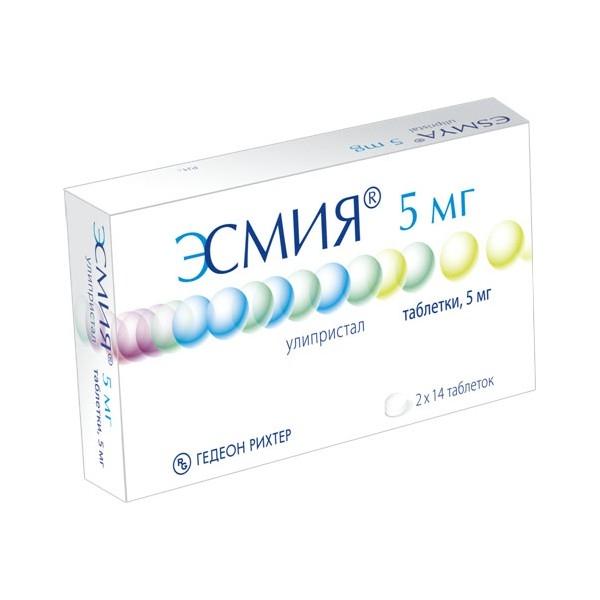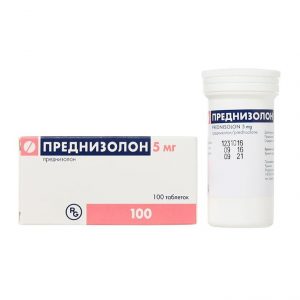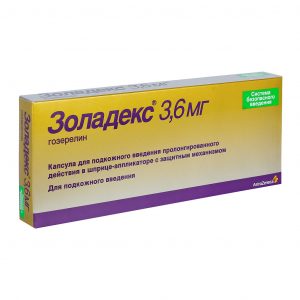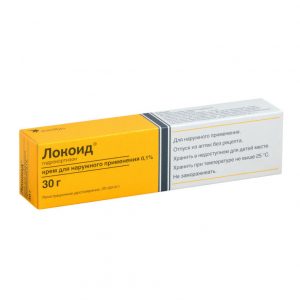Description
Packing
28 pcs.
Indications
Preoperative treatment of symptoms of moderate and severe uterine fibroids in adult women of reproductive age over 18 years (duration of therapy – no more than 2 courses).
Contraindications
hypersensitivity to ulipristal acetate or any of the excipients of Esmiya
vaginal bleeding of unknown etiology or for reasons not related to uterine fibroids
uterine, cervical, ovarian, or breast cancer
(duration of therapy 3 months) due to lack of safety data for longer periods of use)
bronchial asthma, severe form that cannot be corrected by oral corticosteroids
pregnancy
lactation
age ie up to 18 years.
Precautions should be prescribed for renal and / or liver failure, bronchial asthma.
Use during pregnancy and lactation
Ulipristal acetate is contraindicated in pregnancy. Data on the use of ulipristal acetate in pregnant women are absent or limited. Although no teratogenic potential has been identified in animal studies, data on reproductive toxicity are insufficient.
Animal studies have shown that ulipristal acetate is excreted in breast milk. It is not known whether acetate with breast milk is excreted in ulipristal, so the risk to children during breast-feeding cannot be ruled out. Ulipristal acetate is contraindicated in the period of breastfeeding.
Composition of
1 tablet contains:
Active ingredient:
ulipristal acetate 5 mg
Excipients:
microcrystalline cellulose – 93.5 mg,
mannitol – 43.5 mg,
talcardum magnesium, 4 mg
, kcalcard krdm 4 mg – 1.5 mg.
Dosage and administration of Esmiya
is prescribed orally 1 tablet once a day. regardless of food intake for no more than 3 months. Treatment should begin during the first week of the menstrual cycle.
There is no data on treatment for more than 3 months or repeated courses of therapy, so the duration of treatment should not exceed 3 months.
If you miss the next dose, you should take a tablet of ulipristal acetate as soon as possible. If the reception is missed for more than 12 hours, then the missed tablet is not taken, and the usual regimen of administration should be resumed.
In patients with mild or moderate renal failure, dose adjustment is not required. Ulipristal acetate is not recommended for use in patients with severe renal failure if continuous monitoring is not possible.
In patients with mild hepatic impairment, dose adjustment is not required. Ulipristal acetate is not recommended for use in patients with moderate or severe hepatic insufficiency if continuous monitoring is not possible.
The use of ulipristal acetate according to the relevant indications in children is not provided. The safety and effectiveness of ulipristal acetate have been established only for women 18 years of age and older.
Side effects
From the psyche: often – emotional disorders infrequently – anxiety.
From the nervous system: often – headache * (* – see Description of individual adverse reactions) infrequently – dizziness.
From the side of metabolism: infrequently – weight gain.
On the part of the organ of hearing and balance: often – vertigo.
From the respiratory system: infrequently – nosebleeds.
From the digestive system: often – abdominal pain, nausea infrequently – dyspepsia, dry mouth, flatulence, constipation.
From the skin and subcutaneous tissue: often – acne, excessive sweating infrequently – skin lesions.
From the musculoskeletal system: often – bone and muscle pain infrequently – back pain.
From the urinary system: infrequently – urinary incontinence.
From the reproductive system and mammary glands: very often – amenorrhea, thickening of the endometrium *, hot flashes * often – metrorrhagia *, ovarian cyst *, tension / tenderness of the mammary glands, pelvic pain infrequently – rupture of the ovarian cyst, vaginal discharge, enlargement and unpleasant sensations in the area of the mammary glands.
On the part of the body as a whole: often – edema, increased fatigue infrequently – asthenia.
On the part of laboratory indicators: often – increasing the concentration of cholesterol in the blood infrequently – increasing the concentration of triglycerides in the blood.
Description of individual adverse reactions
Thickening of the endometrium
10-15% of patients treated with ulipristal acetate may have a thickening of the endometrium (> 16 mm according to ultrasound or MRI at the end of treatment). This phenomenon is reversible after discontinuation of treatment and the resumption of the menstrual cycle.
In addition, reversible changes in the endometrium, referred to as PAEC, differ from endometrial hyperplasia. The pathologist should be informed about the patient taking ulipristal acetate during histological examination with hysterectomy or endometrial biopsy.
Tides
Tides were observed in 12.7% of patients, but their frequency varied in different studies. In a study with active control, their frequency was 24% (10.5% moderate or severe) for the ulipristal acetate group and 60.4% (39. 6% moderate or severe) for the leuprorelin group. In a placebo-controlled study, the hot flush rate was 1.0% for ulipristal acetate and 0% for placebo.
Headache
Mild or moderate headache was observed in 6.4% of patients.
Ovarian cyst
Functional ovarian cysts that spontaneously disappeared within a few weeks were found in 1.5% of patients during treatment.
Uterine bleeding
Patients with severe menstrual bleeding due to uterine leiomyoma are at risk for increased blood loss, which may require surgical intervention. There were several such reports, both during therapy and 2-3 months after the end of treatment, ulipristal acetate.
Drug interaction
Possible effect of other drugs on the action of ulipristal acetate
Hormonal contraceptives
Ulipristal acetate has a steroidal structure and acts as a selective progesterone receptor receptor modulator. Thus, hormonal contraceptives and gestagens can reduce the effectiveness of ulipristal acetate by competitively acting on the progesterone receptor. Therefore, it is not recommended that the use of gestagen-containing drugs is used at the same time.
CYP3A4 isoenzyme inhibitors
After administration of a medium-capacity CYP3A4 isoenzyme inhibitor, erythromycin propionate (500 mg 2 times / day for 9 days) in healthy female volunteers, Cmax and AUC of ulipristal increased 1.2 and 2.9 AU respectively, respectively. acetate increased 1.5-fold, while Cmax of the active metabolite decreased (0.52-fold). Against the background of the use of ketoconazole (400 mg 1 time / day, 7 days), a potent CYP3A4 inhibitor, healthy volunteers observed an increase in Cmax and AUC of ulipristal by 2 and 5.9 times, respectively. There was a 2.4-fold increase in AUC for the active metabolite of ulipristal with a decrease in its Cmax (a change of 0.53-fold). Dose adjustments for ulipristal in patients, receiving weak CYP3A4 isoenzyme inhibitors is not required. Co-administration of medium-potency or potent CYP3A4 isoenzyme inhibitors with ulipristal is not recommended.
CYP3A4 isoenzyme inducers
On the background of the use of the powerful CYP3A4 inducer rifampicin (300 mg 2 times / day, 9 days), healthy volunteers reported a marked decrease in Cmax and AUC of uripristal and its active metabolite by more than 90%. A decrease in T1 / 2 of ulipristal by 2.2 times was also observed, which corresponds to a decrease in its exposure by about 10 times. Concomitant use of ulipristal and potent CYP3A4 inducers (eg, rifampicin, rifabutin, carbamazepine, oxcarbazepine, phenytoin, phosphenytoin, phenobarbital, primidone, St. John’s wort, efavirenz, nevirapine, nevi ritonavir – against the background of long-term use) is not recommended.
Drugs affecting gastric juice pH
The use of ulipristal (10 mg / day) together with the proton pump inhibitor esomeprazole (20 mg 1 time / day for 6 days) results in a 65% decrease in mean Cmax, a median Tmax elongation of 0.75 h to 1.0 h) and an average AUC increase of 13%. This effect of drugs that increase the pH of gastric juice is not considered clinically relevant for the daily intake of ulipristal acetate tablets.
Possible effect of ulipristal acetate on the effects of other medicines used by other indications. Therefore, concomitant use of gestagen-containing drugs is not recommended. Gestagens should not be used for 12 days after stopping treatment with ulipristal.
Substrates of P-Glycoprotein
In vitro data show that at clinically relevant concentrations of ulipristal acetate during absorption in the gastrointestinal wall may be an inhibitor of P-glycoprotein (P-gp). The simultaneous use of ulipristal and the P-gp substrate has not been investigated, so the likelihood of interactions cannot be ruled out. In vivo data suggest that ulipristal (10 mg tablet) 1.5 hours prior to the administration of fexofenadine P-gp substrate (60 mg) had no clinically relevant effect on the pharmacokinetics of fexofenadine. Therefore, it is recommended to observe an interval of at least 1. 5 hours between administration of ulipristal and P-gp substrates (eg, dabigatran etexilate, digoxin, fexofenadine). The patient should tell the attending physician about all the medicines she is taking, even if they are available without a prescription.
Overdose
There is limited data on the overdose of ulipristal acetate.
A single dose of up to 200 mg and a daily dose of 50 mg for 10 days were administered to a limited number of volunteers, with no severe or serious adverse reactions reported.
Storage conditions
In the dark place at a temperature of no higher than 30 ° C. Keep out of the reach of children!
Expiration
2 years.
Deystvuyuschee substances
Ulyprystal
dosage form
dosage form
tablets




